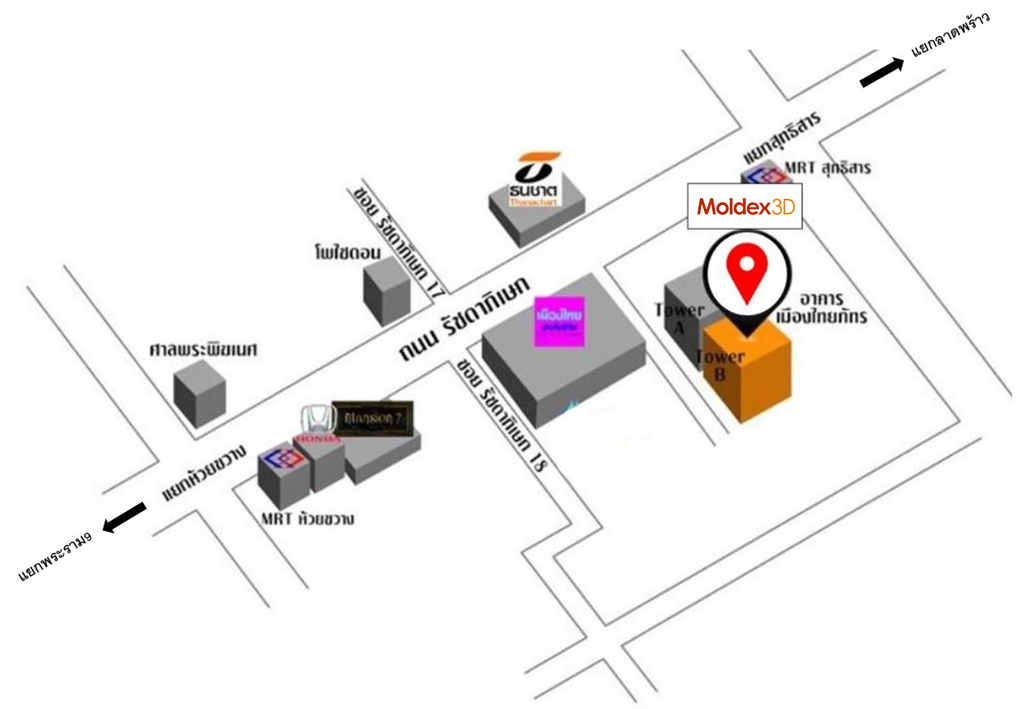- Date:Jun 25, 2019
- Location: Bangkok, Thailand

| Thai Version |
Upcoming Dates
| Date | Time | Register Now |
| April 25, 2019 | 09:00 AM – 4:00 PM | REGISTER |
| May 29, 2019 | 09:00 AM – 4:00 PM | REGISTER |
| June 25, 2019 | 09:00 AM – 4:00 PM | REGISTER |
Description
1. Visualizing Flow Imbalance in Multi-cavity Systems:
Flow imbalance is a main concern for any multi-cavity injection molding systems. By utilizing Moldex3D simulation technology, users can predict Flow imbalanced problem in their system design.
In this course, we will discuss about main Causes of Flow Imbalance:Poor Runner Layout、Shear Heating Effect、Temperature Effect.

2. Predicting Fiber Behaviors
Fiber reinforced plastics (FRP) have been widely applied in industries as a major material in order to reinforce thermal and mechanical properties of plastics with small changes on weight.
Fiber length, orientation and concentration have a great impact on these properties. Part strength can be highly enhanced by raising the fiber length; simultaneously, fiber orientation induced by the flow shear in the molding process causes anisotropic properties to plastics.
To maintain the stability of product quality, the predictions on fiber length and orientation become very important for users to obtain the optimal designs and process conditions.
Otherwise, Moldex3D FEA Interface outputs fiber orientation information and combines with DIGIMAT to provide material information to structural analysis software. We will show a sample how to integrate this process.

3. Warpage Prediction and Shrinkage Compensation Method
Trial-and-error method:Often times experience can help to improve the quality. However, it can be difficult to fit all specifications.
Industrial global compensation method:Based on the average shrinkage to compensate, the result is better than trial-and-error. However, it is still very difficult to fit all specifications at the same time.
3D Volume Shrinkage Compensation Method (3DVSCM):Under the CAE assistance, the shrinkage can be obtained in three dimensions.
After compensating for all areas at the same time, all specifications were able to be obtained.

Outline
| Time | Topic |
| 09:00-09:30 | Welcome & Check-In |
| 09:30-10:40 | Visualizing Flow Imbalance in Multi-cavity Systems |
| 10:40-10:50 | Tea Break |
| 10:50-12:00 | Predicting Fiber Behaviors |
| 12:00-13:30 | Lunch |
| 13:30-14:40 | Warpage Prediction and Shrinkage Compensation Method |
| 14:40-14:50 | Tea Break |
| 14:50-16:00 | Case study for Electric / Automotive |
Date
2019/04/25、2019/05/29、2019/06/25
Location
Building :Muang Thai-Phatra Complex Building-Tower B
252/124 Unit(G) 26th Fl., Tower B Muang Thai-Phatra Complex Building, Rachadaphisek Road, HuayKwang, Bangkok 10310 Thailand
Contact
Ms. Taraporn Harakun
Tel: +66 (0) 2-276-2880
Fax: +66 (0) -2-276-2882
แอดวานซ์แอพพลิเคชั่น
รายละเอียด
1. การแสดงภาพความไม่สมดุลของการไหลในระบบ Multi-Cavity
ความไม่สมดุลของการไหลเป็นปัญหาหลักสำหรับระบบฉีดขึ้นรูปแบบ Multi-Cavity ด้วยการใช้เทคโนโลยีการจำลองการฉีดของ Moldex3D ผู้ใช้สามารถคาดการณ์ปัญหาการไหลที่ไม่สมดุลของ Flow ในการออกแบบระบบของพวกเขาได้
ในหลักสูตรนี้เราจะพูดถึงสาเหตุหลักของความไม่สมดุลของการไหล ไม่ว่าจะเป็น การออกแบบlayoutของรันเนอร์ที่ไม่ดี ผลกระทบจาก shear heating หรือ ผลกระทบจากอุณหภูมิ

2. การคาดคะเนพฤติกรรมของfiber
Fiber reinforced plastics (FRP) ถูกนำไปใช้อย่างกว้างขวางในงานอุตสาหกรรม เป็นวัสดุหลักเพื่อเสริมความร้อนและคุณสมบัติเชิงกลของพลาสติกที่มีการเปลี่ยนแปลงน้ำหนักเล็กน้อย
ความยาวของไฟเบอร์ การเรียงตัวของไฟเบอร์ และความหนาแน่นของไฟบเบอร์มีผลกระทบอย่างมากต่อคุณสมบัติเหล่านี้ ความแข็งแรงของชิ้นงานสามารถเพิ่มขึ้นได้โดยการเพิ่มความยาวของไฟเบอร์ การเรียงตัวของไฟเบอร์ซึ่งเกิดจากการเฉือนการไหลในกระบวนการขึ้นรูป ทำให้เกิดพลาสติกที่มีคุณสมบัติของ anisotropic
เพื่อรักษาเสถียรภาพของคุณภาพของผลิตภัณฑ์ การคาดการณ์ความยาวของไฟเบอร์และการเรียงตัวจึงเป็นสิ่งสำคัญสำหรับผู้ใช้ ในการออกแบบชิ้นงานและกำหนดเงื่อนไขการฉีดให้เหมาะสม
Moldex3D FEA Interface จะแสดงข้อมูลการเรียงตัวของfiberและรวมเข้ากับ DIGIMAT เพื่อให้ข้อมูลวัสดุแก่ซอฟต์แวร์วิเคราะห์โครงสร้าง เราจะแสดงตัวอย่างวิธีรวมกระบวนการเหล่านี้

3. การคาดคะเนการบิดงอของชิ้นงานและการชดเชยการหดตัว (Shrinkage Compensation Method)
วิธีการลองผิดลองถูก:บ่อยครั้งที่ประสบการณ์จะช่วยปรับปรุงคุณภาพของชิ้นงานได้ แต่อย่างไรก็ตามมันอาจเป็นเรื่องยากที่จะพอดีกับข้อกำหนดเฉพาะต่างๆ
วิธีการแก้ปัญหาสำหรับอุตสาหกรรมทั่วโลก:ขึ้นอยู่กับการหดตัวเฉลี่ยเพื่อทำให้ได้ผลลัพธ์ที่ดีกว่าการลองผิดลองถูก อย่างไรก็ตามมันยังคงเป็นเรื่องยากมากที่จะปรับให้เข้ากับข้อกำหนดทั้งหมดในเวลาเดียวกัน
วิธีการชดเชยการหดตัวเชิงปริมาตรแบบ 3D (3DVSCM):ภายใต้ความช่วยเหลือของ CAE จึงสามารถดูผลการหดตัวได้ในรูปแบบสามมิติได้
หลังจากแก้ปัญหาทั้งหมดในเวลาเดียวกันได้ ก็จะสามารถรับรู้ถึงข้อกำหนดเฉพาะทั้งหมดได้เช่นกัน

ตารางเวลา
| เวลา | หัวข้อ |
| 09:00-09:30 | ลงทะเบียน |
| 09:30-10:40 | การแสดงภาพความไม่สมดุลของการไหลในระบบ Multi-Cavity |
| 10:40-10:50 | พักเบรก |
| 10:50-12:00 | การคาดคะเนพฤติกรรมของfiber |
| 12:00-13:30 | พักรับประทานอาหารกลางวัน |
| 13:30-14:40 | การคาดคะเนการบิดงอของชิ้นงานและการชดเชยการหดตัว (Shrinkage Compensation Method) |
| 14:40-14:50 | พักเบรก |
| 14:50-16:00 | Case study for Electric / Automotive |
วันที่
2019/04/25、2019/05/29、2019/06/25
สถานที่
เมือง ไทย-ภัทร คอมเพล็กซ์ ตึก B
252/124 ยูนิต G ชั้น 26 ตึก B อาคารเมืองไทยภัทร, ถนนรัชดาภิเษก เขตห้วยขวาง กรุงเทพมหานคร 10310 ประเทศไทย
ติดต่อ
ธราพร หาระคุณ
โทรศัพท์: +66 (0) 2-276-2880
แฟกซ์: +66 (0) -2-276-2882
